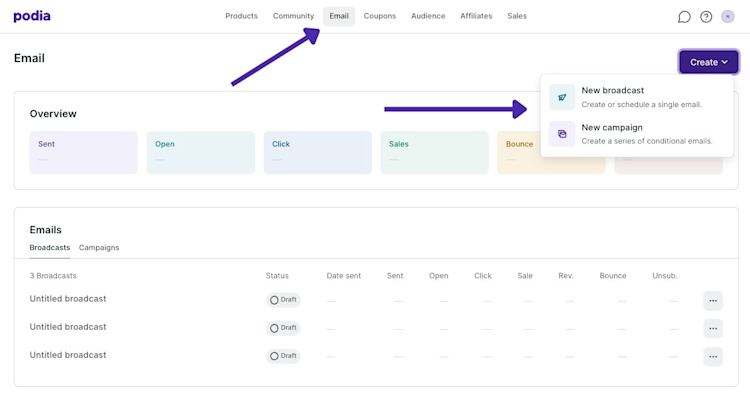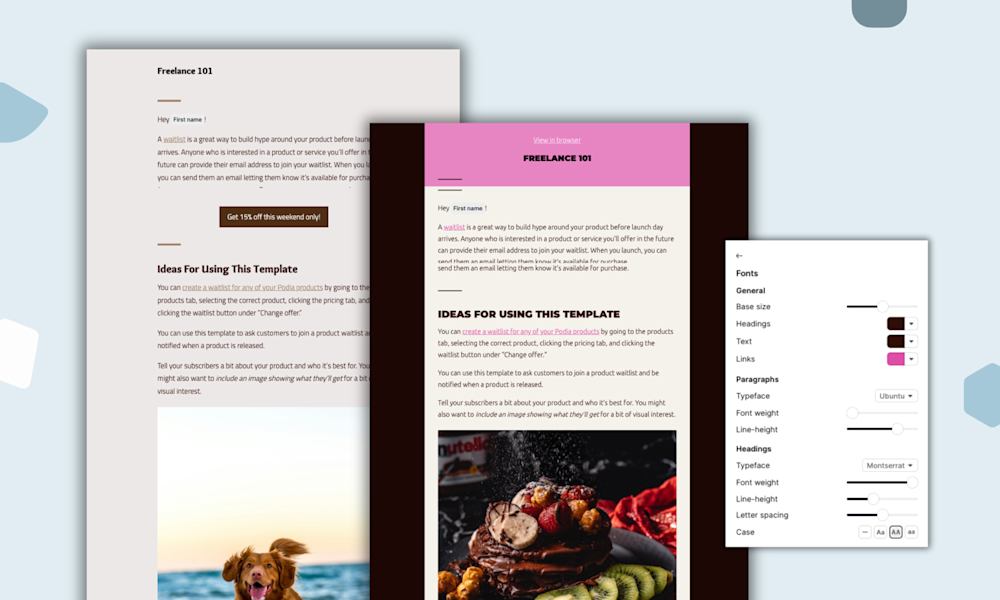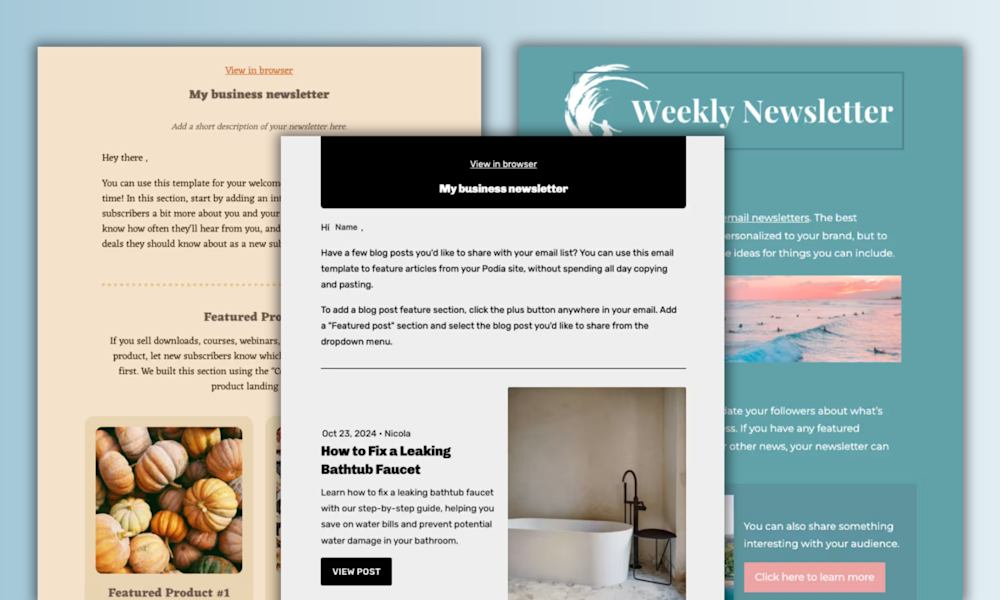You need an email list.
And you need it fast.
With so many email marketing “growth hacks” out there, it’s hard to know what to believe. And you don’t have time to try out every list-building technique and marketing strategy out there to see what sticks.
You need a simple, straightforward solution to build your email list quickly and painlessly.
That’s why we’re sharing five proven tactics to build your email list fast, so you can reach more people and get your product in front of customers who will love it.
-
Pull in site visitors via opt-in popups and lead capture forms
-
Trade expertise for email addresses with lead magnets
-
Turn readers into subscribers with content upgrades
-
Hook new people with a giveaway
-
Reach more audiences through guest posts
But first . . . what’s the big deal about email lists?
Why do you need an email list?
When you talk about starting an online business, you hear a lot about how much you need to grow your email list, especially if you’re in the ecommerce space.
Sure, a big email list gives you access to a lot of people’s inboxes. But there are more benefits to email marketing than just sending out email blasts to a bunch of people at once.
A staggering 4 billion people will use email this year. That’s over half of the world’s population, collectively sending about 306 billion emails per day.
Plus, 73% of consumers rank email as their top-choice channel for marketing messages.
Business owners prefer it, too.
Email is one of the most powerful, scalable, and affordable digital marketing tools out there. As a new business owner, every dollar counts, and email has one of the highest ROIs of any marketing channel.
-
In Q1 2020, traffic from email drove an average order value of $106.32 compared to just $94.02 from search (Google) and $73.64 from social media.
-
In 2018, 59% of marketers cited email as their number one source of ROI.
-
Email marketing has an ROI of $42 for every $1 spent.
When it comes to selling digital products, your email list is the bridge that connects you to your audience. Email lets you share information, pitch products, and develop valuable customer relationships.
Ready to start growing your email list? Keep reading to learn how.
5 proven tactics to build your email list fast
1. Pull in site visitors via opt-in popups and lead capture forms
Marketing emails are kind of like vampires -- they have to be invited in.
Before you can add people to your email list, subscribers need to opt-in and agree to hear from you. Otherwise, your emails show up uninvited in people’s inboxes, and they’re way more likely to mark your message as spam.
(Side note: Never buy a list of email addresses. It might seem like a quick way to build your list, but it can violate the CAN-SPAM Act -- which has penalties of up to $16,000. Beyond that, nothing makes someone hit “unsubscribe” faster than an email they didn’t ask for.)
Make it easy for people to join your email list by adding an opt-in popup or lead capture form to your website.
An opt-in popup is a popup on your site that asks visitors for their email address, usually in exchange for something of value (like a discount or free digital download).
Popups get a bad rap, but done right, they work: A good opt-in popup has a conversion rate of around 9.28%.
WordPress tutorial site WPBeginner used exit-intent popups to grow their email list 600% -- from about 80 new subscribers a day to around 450.
Exit-intent popups use mouse-tracking technology to catch visitors when they’re about to exit your site. Basically, it’s a last-ditch effort to change their minds before they leave forever.
A lot of people (myself included) get annoyed when email opt-in popups interrupt them mid-scroll or halfway through a blog post.
With exit-intent popups, the user is already on their way out. Worst case scenario, they leave anyway. Best case scenario, you get a new subscriber.
One big caveat to lead capture popups: If your site visitors have an ad blocker enabled, they won’t see your popups at all. Make sure they’re not your only opt-in forms, or you’ll be missing out on a big chunk of potential leads.
Likewise, keep an eye on how your popups impact your SEO. Google has some pretty extensive guidelines for its Search Quality Raters that can knock your site down a peg or two if your popups are deemed intrusive or overly distracting.
As an alternative or supplement to popups, consider the less obtrusive opt-in form. These lead capture forms can live on their own dedicated landing pages or hang out on your home page, like this one on Alejandra Rojas's Podia site.

With Podia, you can add a newsletter capture form right on your homepage.
Whether you opt (pun intended) for a popup or an opt-in form, here are a couple of lead generation tips to turn more visitors into subscribers:
-
Use a strong call-to-action (CTA). Tell people why they should subscribe to your email list -- like “Give me the free resources” and “Get the inside scoop” from the examples above.
-
Set expectations. If you have a newsletter signup form, tell subscribers what information you’ll send them and how often.
One of the best ways to turn site visitors into subscribers is to give them something they need -- like, say, a valuable lead magnet.
2. Trade expertise for email addresses with lead magnets
You have expertise and passion to share -- that’s why you started this whole adventure in the first place.
Lead magnets let you share some of that expertise while growing your email list.
A lead magnet is a resource -- usually in the form of a free digital download, such as a white paper on a relevant topic in the niche -- that users receive in exchange for their contact information.
They give you their email address, you give them valuable content. Everybody wins.
Lead magnets show potential customers why they should trust you. The best lead magnets are targeted to your specific audience and their pain points.
Consider 24Slides, a company that sells custom presentations and slide decks. Their customers’ biggest pain point is spending hours trying to create the perfect PowerPoint presentations and pitch decks.
24Slides offered a lead magnet on LinkedIn that addressed that pain point: A 20-slide long template for corporate presentations for free. All users had to do was share the article, leave a comment, and give 24Slides their name and email.
The results were 80,000 new email leads -- all of whom already showed an interest in the types of products 24Slides provides.
For a more (creator) local example, look to Ryan of Signature Edits who offers presets, templates, and training for photographers.
Different photographers run into different pain points, so Ryan offers two different lead magnets: a candid posing guide and a free sample pack of photo editing presets.
“But wait,” I hear you say. “Aren’t these tips supposed to help me grow my list quickly? I don’t have time to make lead magnet content!”
Good news: You don’t have to. Rather than creating content from scratch, repurpose your existing content into a digital download. Turn a long-form blog post into a PDF and offer it as an ebook.
To format your ebook, you can use free online tools like:
-
Reedsy: A free tool that formats and creates an ebook for you.
-
iBooks Author: For Mac users, a tool that lets you add text, graphics, and movies to text to create an ebook.
(Just make sure you check over the final file before you publish it. While the tools above will get most of the legwork done for you, they rarely do it perfectly without human intervention.)
Speaking of converting through content, let’s move on to our next list building strategy: content upgrades.
3. Turn readers into subscribers with content upgrades
A content upgrade is a lead magnet designed specifically for a certain blog post or page on your website. The best content upgrades are relevant to the content they’re attached to and the audience you’re trying to reach.
Overwhelmingly, people prefer to exchange their contact information for actionable, informative content, as you can see in this report from Intercom below:
As much as the writer in me hates to admit it, people don’t always want to read a wall of text. You need to offer them a digestible, actionable alternative in exchange for an email signup.
Types of content upgrades include:
-
Cheatsheets
-
Quick-start guides
-
Checklists
-
Case studies
-
Webinar replays (if it’s the same topic)
If you already have content on your website that brings in a lot of traffic, create content upgrades for your most popular posts.
Here’s how:
-
Identify the content on your site that brings in the most traffic
-
Create a supplemental piece of content that makes your target audience’s life easier
-
Add that content to the relevant page
-
Turn more readers into subscribers!
Sleeknote added content upgrades to their blog posts and grew their email list 28.83% more in just one month.
Granted, Sleeknote is known for their content marketing prowess, but you don’t need their team size to get the same results.
The same thing is true with our next list-building technique.
4. Hook new people with a giveaway
You’re probably starting to sense a theme here . . .
To quote the late-90s one-hit-wonder New Radicals: “You only get what you give.”
What else can you offer your target audience in exchange for their email address?
The chance to win free stuff.
People love giveaways -- and promoting your giveaway on social media can help you grow your following and your email list.
Here’s the catch: Email subscribers from giveaways can be less engaged because they’re more likely to have signed up just to win a prize, rather than to hear from you.
That’s why growth marketing expert and Gleam founder, Stuart McKeown, recommends asking yourself: “What would be an irresistible thing to give away to only my dream customer?” Make that your giveaway prize.
Prizes might include . . .
-
A scholarship to your online course
-
Books that would be interesting to your target audience
-
Software or tools for people in your niche
-
A membership to your online community (similar to Jay Shetty below)
In a super smart move to encourage referrals, Jay also offered prizes to people who shared the contest with their friends.
Once you choose your prize, set up a landing page for your giveaway. Your giveaway landing page should include information about the prize, the rules, and a short entry form.
Don’t worry about SEO too much for these landing pages. Unless you’re going to run a recurring giveaway -- and that can get costly -- you’re better off playing to your audience than to search engines.
As for how, giveaway and contest marketing tools like PromoSimple and KingSumo make it easy to run giveaways that grow your email list.
To grow your reach even further, you can make sharing on social media worth additional entries -- or even a requirement.
Next, promote, promote, promote:
-
Share your contest on your social media pages. Tools like Buffer and Hootsuite can automate this process for you, and, as a bonus, can do it for free.
-
Incentivize social shares and referrals with bonus entries or other prizes (getting you social proof and more potential entries).
-
Ask connections in your industry to share the giveaway with their networks. Offer to promote a piece of their content in exchange.
-
Send an email to your current list -- they’re already subscribers, but they can share with their networks, too. To make it easier, try providing tweet-ready copy for them to use.
-
Submit the giveaway to online contest and giveaway directories, like Giveaway Promote or the r/giveaways subreddit.
Finally, choose a winner and send them their prize.
But don’t forget to follow up with the people who didn’t win the giveaway -- you want to keep them engaged and on your email list, even though they didn’t win. Send them a valuable digital download or a discount code for your site. A little consolation prize can go a long way.
Let’s move onto our final strategy. It’s more of a long-game than our previous strategies, but it’s also arguably the most tried-and-true.
5. Reach more audiences through guest posts
You’re an expert on your topic -- share your expertise with someone else’s existing audience by guest posting on their site.
Guest posting offers a big opportunity to grow your email list. It gets your content, name, and website (with its email capture form) in front of a new audience.
Guest posts may seem daunting: You hardly have enough time to create your own content, let alone write for someone else’s blog.
But just like lead magnets, guest posts are an opportunity to repurpose the content you already spent time and energy creating. Approach the topic from another angle, or reframe it to match the tone and audience of the blog you’re pitching.
After all, it takes an average of 3 hours and 57 minutes to write a blog post -- repurposing your posts for guest blogs makes the most of that time.
Before you write your guest post, though, you have to pitch it.
To find guest blogging opportunities, look for blogs (and bloggers) that:
-
Are in your niche
-
Have an audience that can benefit from your expertise and products
-
Have an engaged readership
-
Actively promote their blog posts on social media
-
Are accepting guest posts
New to pitching? Check out this excellent guide from Jess Ostroff at Convince and Convert. Jess and Jay Baer get over 200 pitches per week -- they know their stuff when it comes to guest blogging.
OK. With all of these strategies in your list-building toolbox, you’re ready to get started with email marketing. Here’s how.
How to get started with email marketing
Once you have an email list, it’s time to send some emails. Your brand-new leads are precious -- make sure to nurture them with the content they signed up for, like a newsletter.
In Podia, you can send email newsletters, drip campaigns, and automated emails to your email list.
To do so, load up your dashboard, then head to the “email” tab, and select which type of email you want to create.

(Don’t have a Podia account yet? Get started for free today.)
To send a newsletter to your entire list, create a new broadcast email. Set your email subject line and who you want to receive your email:
Then write your email message, and you’re ready to send. You can also preview your message or send yourself a test email first to make sure everything looks great.
Pro-tip: If you collect your contacts’ first name in your lead capture form, you can use that to personalize your message.
Grow your email list with these 5 beginner-friendly strategies
Your email list is one of your most powerful marketing tools. It just needs some TLC to help it grow big and strong.
There are tons of different list-building techniques out there. Here are five proven strategies we’ve seen work time and time again:
-
Use opt-in popups and lead capture forms to turn site visitors into email list subscribers.
-
Offer high-value lead magnets in exchange for email addresses.
-
Create digestible, downloadable content upgrades to accompany the top posts on your site.
-
Bring in new subscribers with giveaways that offer something only your audience will love.
-
Pitch guest posts to blogs and reach their already-built readership.
With these email list building tactics in place, your subscriber count is sure to grow. It won’t happen overnight, and we can’t promise 10,000 subscribers in 30 days -- but the email list you build will be an engaged audience who’s excited to learn from you.



